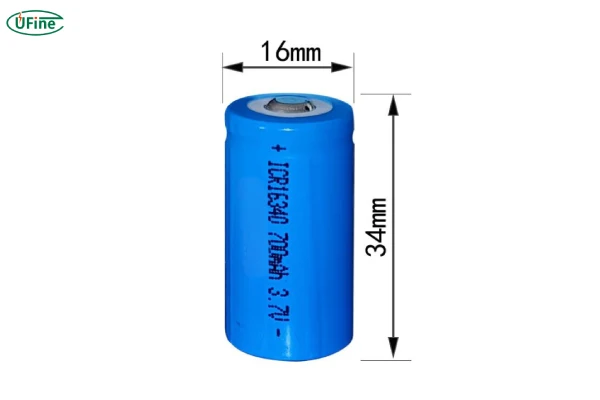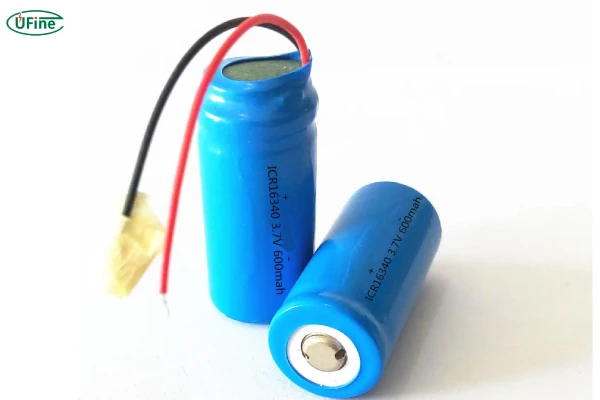If you’ve ever wondered what powers some of your favorite gadgets, like high-performance flashlights or compact cameras, chances are it’s the 16340 battery. Despite its small size, this rechargeable powerhouse is packed with features that make it a top choice for many devices. But what exactly makes the 16340 battery special? How does it compare to similar batteries, and what should you know about using or replacing it?
This guide will answer all these questions and more. Whether you’re a tech enthusiast or just someone looking for reliable battery options, let’s explore everything about the 16340 battery in detail.
Part 1. 16340 battery chemistry

The 16340 battery operates on lithium-ion chemistry, which is renowned for its high energy density and rechargeability. This means it can store a lot of energy in a small size and be recharged hundreds of times.
Key Chemical Components
- Cathode: Typically made of lithium cobalt oxide (LiCoO₂) or other lithium-based compounds. This is where lithium ions are stored during discharge.
- Anode: Usually graphite, where lithium ions migrate during charging.
- Electrolyte: A liquid or gel-like substance that facilitates the flow of ions between the cathode and anode.
- Separator: A thin layer that prevents short circuits by keeping the cathode and anode apart while still allowing ion flow.
Learn About the Cathode and Anode of the Battery
Working Principle
When the battery is in use, lithium ions flow from the anode to the cathode through the electrolyte, generating electricity. During charging, this flow is reversed, restoring the ions to the anode.
This efficient energy transfer process is why the 16340 battery delivers reliable performance even in high-drain devices.
Part 2. Characteristics and specifications
Understanding the technical specs of the 16340 battery helps you see why it’s a favorite among compact devices. Let’s dive deeper into its key characteristics:
| Specification | Details |
|---|---|
| Nominal Voltage | 3.7V |
| Fully Charged Voltage | 4.2V |
| Capacity | 600–850mAh |
| Size | 16mm diameter, 34mm length |
| Weight | ~20 grams |
| Cycle Life | 300–500 cycles |
| Self-Discharge Rate | ~5% per month |
Unique Features
- Compact Design: Measuring just 16mm by 34mm, the 16340 fits perfectly into small devices where space is at a premium.
- High Energy Density: It provides consistent power output, making it ideal for high-drain devices like flashlights.
- Lightweight: At only around 20 grams, it’s portable enough to carry spares without adding much bulk.
- Rechargeable Nature: You can recharge it hundreds of times, saving money and reducing environmental waste.
Part 3. Protected vs. unprotected 16340 battery
One of the first decisions you’ll face when buying a 16340 battery is choosing between protected and unprotected versions. So, what’s the difference, and which one is right for you?
Protected 16340 Batteries
Protected batteries have a built-in protection circuit module (PCM). This feature prevents:
- Overcharging: Stops charging when the voltage hits 4.2V.
- Over-discharging: Cuts power to avoid draining below 2.5V.
- Short Circuits: Reduces risks of overheating or damage.
Pros:
- Safer to use, especially in devices without built-in safety mechanisms.
- Ideal for beginners or people prioritizing peace of mind.
Cons:
- Slightly larger, which may cause fitting issues in some devices.
- More expensive than unprotected versions.
Unprotected 16340 Batteries
Unprotected batteries lack the PCM, making them smaller and lighter. However, this also means they’re more prone to misuse.
Pros:
- Cheaper and often more powerful.
- Fits devices with tight compartments.
Cons:
- Higher risk of overheating or damage if not used carefully.
Part 4. 16340 vs. 18650 battery: what’s the difference?
At first glance, the 16340 and 18650 batteries might seem similar—they’re both lithium-ion and rechargeable. However, their differences are significant.
| Feature | 16340 | 18650 |
|---|---|---|
| Size | 16mm x 34mm | 18mm x 65mm |
| Capacity | 600–850mAh | 2200–3500mAh |
| Voltage | 3.7V | 3.7V |
| Applications | Flashlights, cameras | Laptops, power tools |
| Weight | ~20 grams | ~45 grams |
Why Size Matters
The 18650 is significantly larger, so it’s better suited for devices that require more power over longer periods, like laptops or power tools. On the other hand, the 16340’s smaller size makes it perfect for compact devices.
Part 5. Can an 18650 battery replace a 16340?
In short: no, and here’s why:
- Size Difference: The 18650 is too large to fit in most devices designed for 16340 batteries.
- Power Output: The higher capacity of an 18650 could overload devices meant for the 16340.
Stick to the recommended battery type to avoid damaging your gadgets.
Part 6. 16340 vs. CR123A: rechargeable vs. disposable
The CR123A battery is often compared to the 16340 because of their similar size. However, the two are quite different:
| Feature | 16340 | CR123A |
|---|---|---|
| Rechargeable | Yes | No |
| Voltage | 3.7V | 3.0V |
| Capacity | 600–850mAh | ~1500mAh |
| Applications | High-drain devices | Emergency backups |
Part 7. Can CR123A replace a 16340?
While they may look similar, the voltage difference (3.0V vs. 3.7V) can cause problems. Some devices can handle the lower voltage of a CR123A, but others may not function properly. Always check your device’s specifications before making a swap.
Part 8. How to charge a 16340 battery safely
Charging the 16340 is straightforward but requires care to maximize its lifespan:
- Choose a Compatible Charger: Look for chargers designed for lithium-ion batteries.
- Monitor Charging: Never leave the battery unattended during charging.
- Remove When Full: Overcharging can reduce the battery’s lifespan.
Part 9. What battery can replace a 16340?
If you’re in a pinch, you might consider alternatives like the RCR123A. These batteries are similar in size and voltage, making them a good substitute in many cases.
Part 10. Conclusion
The 16340 battery is a compact, versatile power source that’s perfect for high-performance devices. Whether you’re comparing it to the CR123A or the larger 18650, understanding its features and proper usage ensures you get the most out of your investment.
Related Tags:
More Articles

How to Choose the Best Floor Scrubber Battery for Commercial Cleaning?
Selecting the ideal floor scrubber battery ensures a long runtime, rapid charging, and minimal maintenance for efficient commercial cleaning operations.
Battery for Blower vs Battery for Leaf Vacuum: Which One Should You Choose?
Battery for blower vs leaf vacuum—learn the key differences in power, fit, and runtime to choose the right battery for your outdoor tool needs.
How to Choose the Right Battery for Blower?
Choosing the right blower battery? Consider voltage, capacity, chemistry & usage. This guide helps match the best battery for peak performance.
How to Choose the Best Insulated Battery Box for Lithium Batteries?
Choosing the Best Insulated Battery Box for Lithium Batteries? Discover key factors such as size, material, and safety for optimal protection and performance.
7 Critical Elements on a Lithium Battery Shipping Label
What must be on a lithium battery shipping label? Learn 7 key elements to ensure safety, legal compliance, and correct handling across all transport modes.




